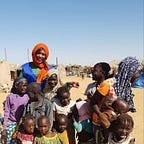The wings that connect Mali
How the United Nations Humanitarian Air Service (UNHAS) is enabling access for aid workers in the vast country hit by conflict
It is 08:30 am at the Modibo Keita International Airport at Senou-Bamako. I am boarding an UNHAS flight with other aid workers. The final destination is Menaka located some 1,500 km from the capital Bamako, and 100 km away from Niger. It is one of the most challenging cities for humanitarians to access because of the distance as well as insecurity.
Once aboard, we faithfully follow the crew safety briefings. The Dornier 228 aircraft revs up and off we go. The flight will stop in Mopti, in the cental part of the country, then Gao in the north before it arrives in Menaka.
High in the sky, the atmosphere is relaxed — some passengers are reading, others are having a snooze, and a few more are chatting. I look out the window and capture a snapshot of Bamako below us.
Ibrahim Al Mahamadou will be sitting next to me for two hours. He works for the German cooperation (GIZ) in Gao. He was in Bamako to attend his organization’s annual performance planning meeting, which helps them adjust their programmes to serve people better.
We chat about the challenges people living in Gao have been experiencing since crisis erupted in 2012; the services provided by aid groups but also the difficulties of humanitarian access — one of which is physical like travelling by road from one place to another to reach people in need of assistance.
“If it weren’t for UNHAS it might have taken me two days to travel here by road,” Ibrahim tells me. “With the poor state of the Gao-Bamako road and to avoid all the robbers who often attack passengers, I would have been forced to cross over to drive via [neighboring] Niger to reach Bamako,” he adds.
Mali is a huge country. The absence of viable commercial airlines to transport humanitarian actors to project sites led to the setting up of the UN World Food Programme (WFP)-managed UNHAS operation in the country in 2012.
“ During holidays, UNHAS is the only way for us to connect from our very difficult duty stations to Bamako or other cities where our families and friends live,” Ibrahim explains.
After stop-overs in Mopti and Gao we finally land in Menaka. Here, a quick turnaround is necessary because the city is regularly targeted by non-state armed groups.
“Land transport to and from northern Mali is subject to frequent ambushes and the danger of improvised explosive devices,” says Nicholas Mogire, the Aviation Security Officer for UNHAS in Mali. “Today, more than ever before in Menaka, there are real risks for humanitarians,” he adds.
I decide to observe UNHAS staff to see what they do when on the ground in a place like Menaka. There is an inspection of the aircraft, discussions with pilots and crew. From a distance, I could see one of them walking carefully on the runway. Why is he doing that, I wonder.
“We meticulously inspect every aspect of a flight, including the aircraft and runway,” explains Amara Fofana, who is an UNHAS Air Transport Officer. “We collaborate with Malian civil aviation authorities to transport our passengers in the most reliable and secure way possible.”
“As UNHAS focal point in Menaka, I can tell you without a doubt how much the humanitarian community here is happy to be able to carry out its activities between the regions without having to fear for the safety of their staff,” says Moussa ag Amini, who works for ACTED, a French charity which operates in Mali.
It is his organization that leads the liaison between the aid agencies and the air service in Menaka. They receive training in aviation safety and security from UNHAS.
“We are the ones who are seeking new destinations because of the activities we have in the areas and when these air routes are available we volunteer to ensure the smooth running,” explains Moussa ag Amini
In addition to transporting people, UNHAS undertakes several medical and or security evacuations. The service also regularly delivers cargo — usually essential medicines, food, and IT supplies.
I am full of admiration of the work done by UNHAS as I return to Bamako.
In 2018, the air service transported 10,204 passengers belonging to 144 organizations, and nearly 40 tons light of cargo in Mali. This was made possible thanks to funding from the EU’s directorate of European Civil Protection and Humanitarian Aid (ECHO), Germany, Luxembourg, Norway, Spain, Sweden, Switzerland, the UK Department for International Development (DFID) and the Office of US Foreign Disaster Assistance (USAID / OFDA).
